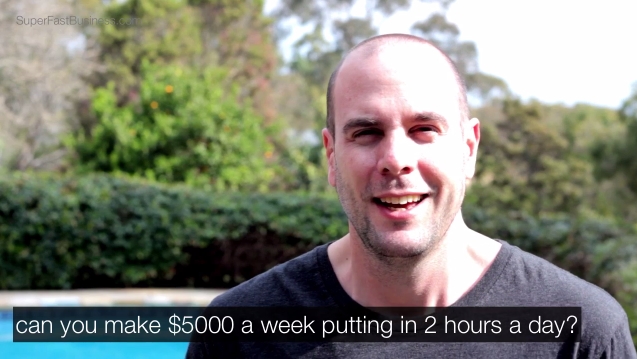Podcast: Download (Duration: 1:09:52 — 64.7MB)
Get Notified Of Future Episodes Apple Podcasts | Spotify | Amazon Music | Android | Blubrry | Gaana | TuneIn | Deezer | Anghami | RSS | More
How to make 100K a month is a question James and guest Rick Mulready have both answered. They share the nine ways they’ve done it, in this special episode.
Our experts discuss the counterintuitive principle of making more when you simplify your business.
James shares three elements of a high-earning business model.
And he and Rick cover the importance of offer, traffic channel, innovation and much more.
Table of contents
1. You need less, not more
2. Determining the right business model
3. Consider the quality of your offer
4. What is your core traffic channel?
5. If you want to stay around, innovate
6. Do you have enough whitespace?
7. Having fun on purpose
8. You’ve got to have a team
9. You’ve made the money – now let it work for you
You need less, not more
James kicks off the first step: less. You need less stuff.
People looking at James’s business now think it’s quite simple. It wasn’t always.
James has had to declutter, rearrange, let stuff expire, prune and tune his product lines. And he now has less than he’s ever had since he ventured online.
Over the years James has discovered the small percentage of things that actually matter, and let go of the rest. At one time he had 10 profit pillars, as a buffer against possible financial setback; he had a team of 65, and worked seven days a week, on and off.
In 2022, with a team of six, a couple of memberships, some rev share partners and affiliate deals, James works three days a week and is both the most profitable and the most relaxed he’s ever been.
Rick was once in the corporate world, working for AOL, Yahoo, Funny or Die. He gave it up in 2012 and ran Facebook ads for people, releasing a Facebook ads course called FB Advantage.
In 2015 Rick also had a Facebook ads program for local businesses. And he kept adding to his offerings at the suggestion of other people: You should serve ad managers; you should have a membership; you should do a coaching program…
It came to where Rick was serving three different audiences within six offers, and wasn’t happy. His company hit the million-dollar mark in the first four years, but he knew it wasn’t sustainable – It was literally, he says, killing him.
Over the years, James has helped people like Ryan Levesque, who went from one to $10 million when they worked together, and Ezra Firestone who started with a couple of grand and later hit $65 million. For both it was a matter of finding their thing and doubling down on it – not a lot of moving parts.
If you feel like you’ve got too much going on, says James, and you feel that’s the measure of success, he would say the measure of success is just getting really clear on the few things that actually matter, and deleting, purging, selling off all the rest.
Need help simplifying? Have a chat to him or Rick – they’re good at it.
Determining the right business model
Point two is your business model.
James and Rick have both found online business to be a relatively easy way of making $100K per month.
James likes online because the margins are good, and cash flow works well.
Online, your team can be anywhere in the world. You can choose who you want, at what rates, and access a variety of talents.
Under business model, three elements in particular will help you make good money:
a. Higher price points. People typically go for low ticket, because it seems an easy entry point. What they don’t realize is the volume needed to make it work, and how competitive it is. James has always gone medium to high.
b. Recurring. Almost everything James does is recurring. He’s done one-time, and it’s exhausting.
c. Performance-based deals. This is a game-changer. Revenue shares let James participate in someone else’s business as a partner and receive a percentage of revenue when the business does well.
Stack these together, says James, and you’ll be making $100,000 a month.
It’s been a year and three quarters since Rick started working with James, and he wants to share an episode he’s done about how to choose a coach. It’s at rickmulready.com/649.
He shares it because everything he discussed there lead to his working with James, and they’ve since applied everything James has just described to Rick’s business.
At the time, Rick was in the process of simplifying and had two 12-month programs – Offer to Optimized, and Accelerator. Accelerator sold for two grand a month; the other, Rick can’t even remember.
It was a couple of hundred dollars, says James, which annoyed him. He’s always found when he checks his own numbers that around five sevenths of his income comes from a higher-ticket program serving a fraction of his customers.
In his book, Work Less, Make More, James talks about the rule that 10 percent of your audience will pay 10 times more for what you have to offer. It’s certainly held true for James, with nine partners generating half his income, 80 to 90 people making up most of the rest, and then entry point customers.
Consider the quality of your offer
Number three is a great offer – that is something offering value to the client.
It’s been James’s constant advice from the beginning. And he’s found, too, that getting a proper sales page done by a good copywriter makes a difference.
Lately James and his team have been focusing on much better headlines for their podcast titles and YouTube snippets. Just that has gotten them over a thousand views on social where they used to get just 20 or 30.
Everyone listening should have some interest in sales copy, says James. A tool like Jasper can help, but there are any number of resources out there – classics like the Gary Halbert letter, or Trevor Toecracker Crook, who’s been several times a guest on the show.
The main elements of a great offer are:
– It has to be compelling.
– It’s got to be better value for the client than what they’re paying.
– It should be easy to understand.
– It should be easy to know what the next step is.
– There should be an amazing headline and bullet points and images.
– There has to be proof. Of all the elements, James thinks this is the absolute top dog, and something that’s usually missing.
In Rick’s experience, when people’s ads aren’t working, it could be the setup, but nine times out of 10, it’s the offer. They don’t understand their target audience so they don’t understand the problem they’re trying to solve.
Whether for a lead magnet, an opt-in, a video, or whatever a Facebook ad talks about, you’ve got to have an offer that people want. And that comes from testing, which comes from improving the copy and the messaging, the titles, specifically.
You can’t do much until you have what James call an offer that converts. And then people need to know about it – you could have the greatest offer in the world, but if it’s a secret, it’s not going to sell.
One of the first questions Rick asks his coaching students is, what does your offer do? And very often they can’t clearly articulate that.
Most sales pages are selfish, says James, loaded with I, me, my, our… The person coming to your page doesn’t care about you – they care about themselves.
James has a tool on his site, the 16-Word Sales Letter tool, which is a great starting point. But good copy is important enough that you may need to hire someone.
What is your core traffic channel?
Moving on, four is the traffic channel.
Both James and Rick do podcasts, and have for a while. For James, it’s the core, augmented with short video content, snippets from his podcast videos, on YouTube and social.
In terms of paid traffic, James has just ads on Amazon for his book, and a Google campaign for his own name, which he considers essential.
You need a traffic channel, says James, that you can lean heavily into and sustain. What are Rick’s thoughts?
A hundred percent. 2021 was amazing in terms of applications for Rick’s program, and he asks applicants where they heard about his product – 99 percent, easily, is Rick’s podcast.
Like James, Rick does two episodes a week, has done for years, and they do very well with reach.
Rick gets an enormous amount of traffic, says James. When he guested on Rick’s show, it had the Rick Mulready effect, something James has only experienced on Pat Flynn’s podcast.
If you want to stay around, innovate
Number five is a quick one: innovation. This mitigates risk – if you want to keep making $100,000 per month, you need to stay sharp.
James has been in the game for a while but keeps getting exposed to new information. Clients bring him things – he’s interested in new tools, the new ways they’re getting traffic, what’s stopped working.
You don’t want to be the last person to find out something doesn’t work anymore. That means you’ve got to keep an eye on your data, pay attention to what’s happening.
As you grow your business, if you go from $100,000 a year to $100,000 a month, a lot of what you’re doing now won’t work. You need to innovate.
When James quit his job, he committed to stay up to date and ahead of the pack, keep it sharp, and not get complacent and sit. At date of recording, he and his team have just migrated their whole platform – no small undertaking, but necessary to stay fresh and current.
Like James, Rick has a lot of members doing different things, which lets him see inside their businesses at what is and isn’t working. And like James, he knows a lot of people and has a lot of conversations.
You need the ability to have insight into what’s going on, says Rick.
And a big thing Rick tells his Accelerators is, be willing to look at what’s working in other niches. Why not take what’s working for someone in that niche over there, and see what you can do with it in your own niche, in your business?
It’s another, simple way of innovating that many people tend to tune out.
Do you have enough whitespace?
Next up is whitespace.
James sees people working too much, becoming dulled and drained, no longer excited about their business. What they’re doing isn’t sustainable, and sustainability is very important.
Growth for the sake of growth can wear you out. So create the whitespace at work that allows you to continue.
A big tip James shares with people is, if you have a workday, put a massive space in between the morning and the afternoon. Not just half an hour or an hour, but three, four hours – when you go back to work in the afternoon, you’ll feel like a new you.
And don’t work seven days a week – at least take a workday off. James has pared down his routine to three days a week.
Rick has been taking three-day weekends for a long time. And one of the first conversations he had with James was on the thing he did to get away from business.
For James, of course, it’s surfing. And the counterintuitive thing is the ideas and solutions he comes up with for his and other people’s businesses while he’s on the water.
Because you’re removing all the stimulus, says James, all the things that hinder your thinking.
Having fun on purpose
Rick’s surfing is bass fishing.
James wants to roll that into its own number, seven: Do something for fun.
This is beyond whitespace – it’s intentional.
The day before recording, James surfed for the first time after three weeks healing broken ribs. It was the best reset imaginable, he says – healing, soothing, like saltwater therapy.
And fun is important, James says. You’re not the same person without it.
Almost everyone who works with James is not having fun when they start, and Rick finds the same.
People think you have to work harder to succeed in business, says Rick. But when you build in that time to do whatever you enjoy, that’s where ideas come from.
And you are in a much better place to do that stronger work, with a clearer mind, to serve whoever you serve in your business.
You’ve got to have a team
James has talked a lot about number eight, having a team.
You won’t make $100,000 a month by yourself, unless you write a hit song or some amazing software, or you excel at revenue share deals and using someone else’s team. You likely need a team, even a small team of assistants.
James likes having a team because he can buy time. If you don’t want to put in the time and you can buy the time, it’s massive leverage.
With a team, you’re leveraging all the talents and the synergy of those people working together. James loves his team of six – together, they’re powerful, they can get everything done.
James does the bits his team would rather not do – recording podcasts and mentoring clients. His team handle support, keep websites running, process content, send out emails, do the accounting and check the numbers.
A lot of Rick’s clients tell him they’re not good managers, wouldn’t know how to run a team – it’s a big thing he helps people with in his program. He himself has always had a small team, though he used to think he wanted a big one.
Rick wants to give a shameless plug for the recruitment service James and his wife run, VisionFind.com. He hired a VA from them maybe two months ago, and with zero online business experience prior, she does an amazing job.
The secret sauce, says James, is their candidates aren’t worn-out hacks on jobs boards. They don’t know much about online business, but James and his wife bring them into the industry, and they’re ready for formatting and training.
You’ve made the money – now let it work for you
James wants to round things out with number nine. It’s really simple, he says.
At some point, you’re bringing in all this money – now get that money working for you. It’s investing.
In the last year, James has spent a lot of attention on this, and he and Rick talk about it all the time: you’ve got this money from the business – what are you going to do with it?
James wants his money to work and to make more money, and over the next few years, to supplement his work income, his business income, and eventually replace it, and then there’ll be no need to work.
That’s possible, he says. It’s already happening in a small way, and it’s going to compound and leverage over time.
That’s what Rick does with his revenue share income. It goes right into wealth-building.
It’s something he didn’t do a good job of early on, Rick admits. And it’s a regret, but he can’t fix that – all he can do is change it going forward.
Rick has people in his program doing five million a year, three million a year, and they’re not thinking about wealth-building. It’s so important.
Save yourself having to work in five to seven years from now, that’s the point, says James. He’s not giving any advice today on this episode, though – he’s done several episodes with other people on the topic and just wanted to put it in there.
So in summary, they’ve shared nine steps for how to make 100K in a month. Doing less, having the right business model, making a great offer, having a core traffic channel, innovating, getting whitespace for yourself, having fun, building a team, and then investing.
You’ll get free access to two related trainings via this episode’s PDF resource – How to Recruit Your Next Team Member, and How to Put Together Revenue Share Deals.
Get world-class business resources, mentoring and support inside the James Schramko community
Enjoyed the show? Leave us a review on iTunes













Leave a Reply